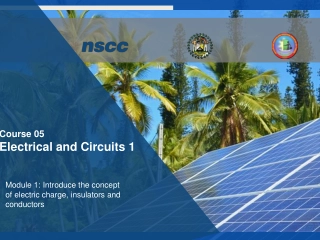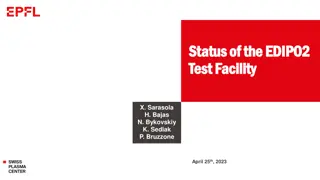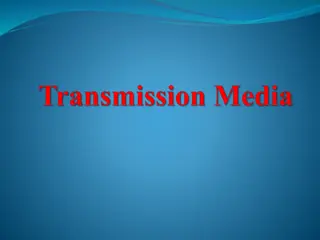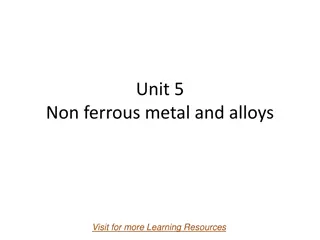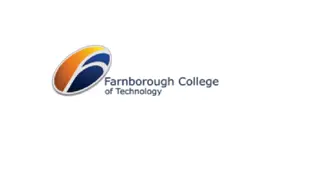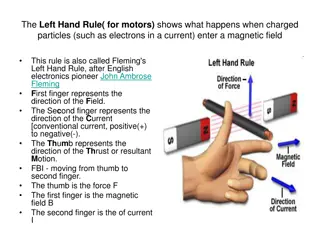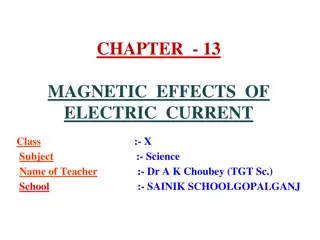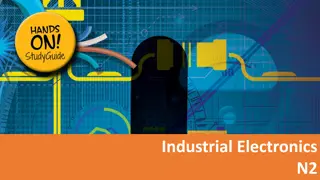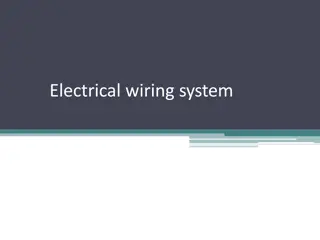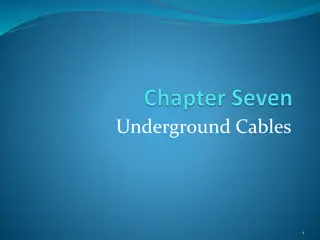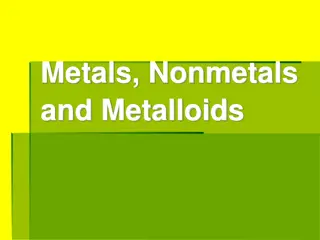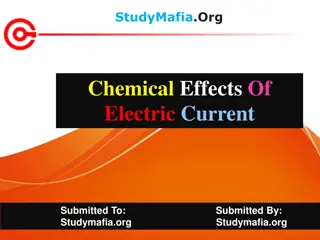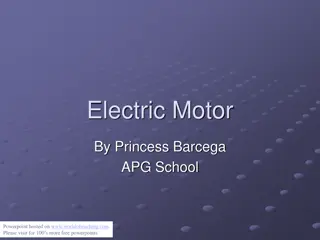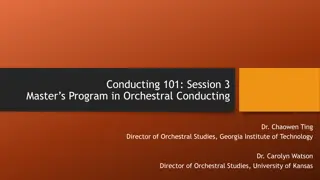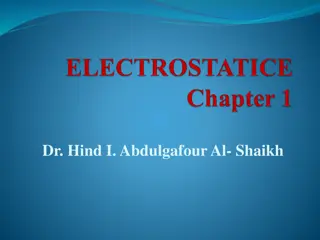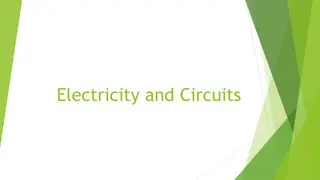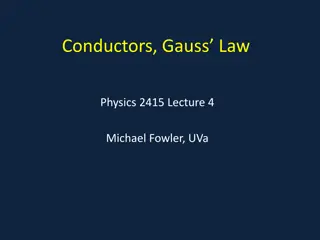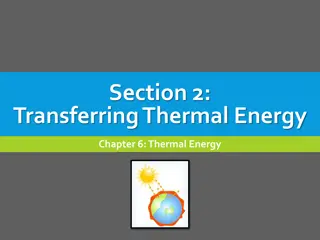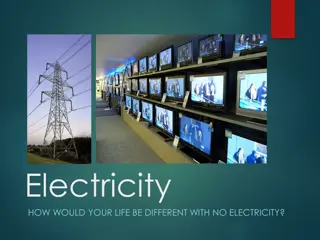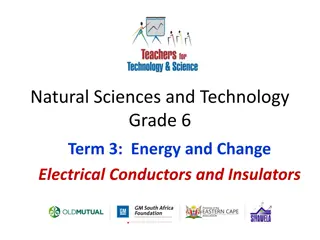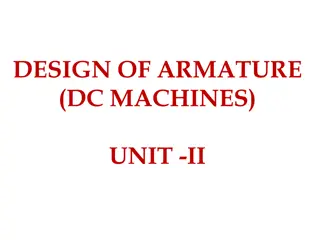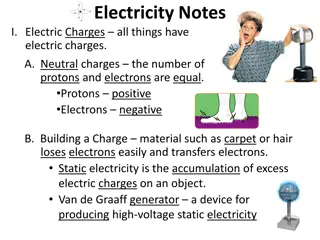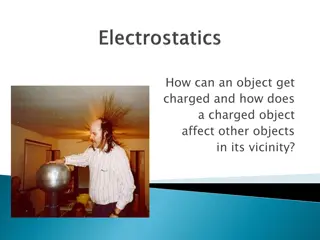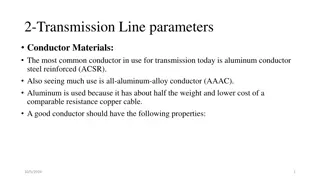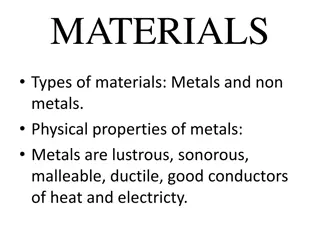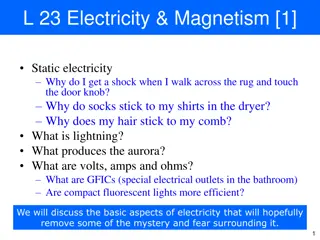Electrical and Circuits 1
Electric charge, insulators, conductors, and electrical flow through materials. Understand static electricity and examples of static charge uses. Discover the concept of insulators with analogies and examples.
0 views • 26 slides
Understanding the EDIPO2 Test Facility at Swiss Plasma Center
The Swiss Plasma Center at cole Polytechnique Fdrale de Lausanne (EPFL) houses the Superconductivity Group responsible for testing superconductor samples for projects like ITER, DTT, and DEMO. The facility comprises two test facilities, SULTAN & EDIPO, and engages in activities like developing condu
4 views • 40 slides
ECE 305 Electromagnetic Theory
Explore the fundamental concepts of electric fields in material space, covering topics such as free space, conductors, insulators, semiconductors, current conduction, and charge density. Delve into the properties of materials, convection vs. conduction current, and the role of superconductors in ele
1 views • 25 slides
Exploring Electricity Concepts: From Atoms to Static Electricity
This content delves into the basics of electricity, covering topics such as atoms, charges, static electricity, simple circuits, and more. Learn about the difference between naturally occurring and human-harnessed electricity, explore the concept of charges in objects, and discover how static electr
5 views • 14 slides
Understanding Electricity and Circuits: Basics, Components, and Applications
This educational course covers topics such as circuit symbols, calculating and measuring electrical quantities, identifying circuits, and understanding the relevance of electricity in engineering. It explains essential circuit components like energy sources, conductors, insulators, loads, control de
12 views • 30 slides
Understanding Chemical Bonds and Ionic Compounds
Ionic bonds are formed when atoms transfer electrons to achieve stable electron configurations, resulting in the creation of ions with positive or negative charges. Metals are good conductors due to their ability to easily lose electrons. The charges of ions depend on the number of valence electrons
0 views • 49 slides
Understanding Transmission Media and Twisted Pair Cables in Communication
Transmission media plays a crucial role in communication by transmitting data through electromagnetic signals. It is classified as guided media (using cables) and unguided media (waves through air, water, or vacuum). Twisted pair cables are a common type of guided media, consisting of insulated cond
5 views • 32 slides
Electrical Conductor Ampacity Calculation Scenarios
Various scenarios are presented involving the calculation of allowable ampacity for different types of electrical conductors connected to circuit breakers with temperature limitations. The calculations consider factors like conductor material, size, temperature ratings, and ambient conditions to det
0 views • 140 slides
Properties and Applications of Copper Alloys
Copper and copper alloys are essential materials due to their excellent properties like ductility, malleability, high conductivity, and corrosion resistance. Various types of copper alloys such as brasses are widely used in electrical conductors, utensils, coins, and industrial applications. Underst
0 views • 28 slides
Understanding Insulators: Properties, Materials, and Testing
An insulator is a crucial device used to support and insulate electric conductors or equipment from ground or other conductors. This article covers the definition, desirable properties, materials used, ratings, and testing methods of insulators, including flashover tests, sample tests, and routine t
1 views • 33 slides
Understanding Electron Theory and the Structure of Matter
The structure of matter is intricately tied to electron theory, where molecules are made up of atoms containing protons and electrons. An electrically neutral atom has an equal number of protons and electrons. A flow of electrons creates an electric current, which can be measured by an ammeter. Cond
0 views • 11 slides
Understanding Thermal Conductors and Insulators in Energy Transfer
Today's lesson focuses on energy transfer, specifically on conductors and insulators. Learn about the characteristics of thermal conductors and insulators, how they affect the flow of thermal energy, and their real-life applications. By the end of this lesson, you will be able to distinguish between
0 views • 13 slides
Understanding Fleming's Left Hand Rule and Electric Motors
Fleming's Left Hand Rule, also known as the Left Hand Rule for Motors, explains the interaction between charged particles and magnetic fields. Electric motors utilize this principle to convert electrical energy into mechanical energy through the interaction of magnetic fields and current-carrying co
2 views • 6 slides
Understanding Magnetic Effects of Electric Current in Science Class
Explore the magnetic field and field lines, understand the magnetic effects of current-carrying conductors, learn about the right-hand thumb rule, and discover the magnetic field due to current through a circular loop in Chapter 13 of Magnetic Effects of Electric Current in Science Class at Sainik S
0 views • 17 slides
Understanding Electrical Principles in Industrial Electronics
Explore the fundamentals of industrial electronics, starting with direct current principles related to atomic theory, conductors, insulators, and resistors in series and parallel. Then, delve into alternating current principles, including generating an alternating voltage, alternating current (AC) b
0 views • 46 slides
Understanding Electrical Wiring Systems and Their Importance
Electrical wiring systems consist of insulated conductors that supply power to various appliances in homes and buildings. The selection of wires is crucial based on factors like current rating, cost, and application. Different types of wiring exist for domestic, commercial, and industrial purposes,
1 views • 30 slides
Understanding Electrochemistry in Engineering Chemistry
Electrochemistry in engineering chemistry explores the interactions between electrical and chemical energy, involving the conversion of energy forms. It discusses electrical conductors, insulators, metallic conductors, good conductors, semiconductors, and electrolytic conductors. The concept of elec
4 views • 56 slides
Advantages and Requirements of Underground Cables
Underground cables offer advantages like better protection from damage, fewer faults, and improved appearance. However, they come with higher installation costs and insulation challenges at high voltages. Requirements include using high-conductivity stranded copper or aluminum conductors, proper ins
0 views • 22 slides
Understanding Metals, Nonmetals, and Metalloids in the Periodic Table
Explore the characteristics and physical properties of metals, nonmetals, and metalloids. Learn about the differences in appearance, conductive abilities, malleability, ductility, and other key features of these elements. Discover why metals are excellent conductors of heat and electricity, while no
0 views • 18 slides
Understanding Electrical Conductors and Insulators
Electrical conductors like metals allow the flow of charge, while insulators like wood and plastic impede the flow. Copper, silver, and aluminum are examples of good conductors, with high conductivity. Insulators have high resistivity, preventing the easy flow of electric current. Learn about the pr
3 views • 5 slides
Understanding Chemical Effects of Electric Current
The chemical effects of electric current involve reactions in conducting solutions through which an electric current passes. This phenomenon leads to various effects like electroplating, formation of gas bubbles, deposition of metals, and changes in solution color. Conductors play a vital role in al
5 views • 17 slides
Understanding Magnetic Forces in Electric Motors
Explore the intricate relationship between magnetic forces, current-carrying conductors, and electric motors with detailed explanations and visual aids. Discover the principles behind Fleming's left-hand rule, the directional relationship of current and magnetic field, and the motion of current-carr
3 views • 20 slides
Understanding the Role of Councillors in Local Governance
Explore the significance of councillors as essential conduits between officials and the public in local governance. Delve into their roles as lightning conductors and barometers, interpreting public sentiment and providing leadership. Gain insights into enhancing collaboration with councillors for e
0 views • 37 slides
Master's Program in Orchestral Conducting: Insights and Considerations
Discover the essentials of pursuing a Master's degree in Orchestral Conducting, including reasons for seeking the degree, qualities to look for in a program, factors to consider, and tips for selecting the right school. Unveil a comprehensive guide for aspiring conductors looking to enhance their ex
0 views • 13 slides
Understanding Electric Charges and Conductors in Physics
Explore the fundamentals of electrostatics, electric charges, conductors, and insulators in physics. Learn about the Law of Electric Charges, types of charge, conductors vs. insulators, and methods of charging objects through friction, conduction, and induction. Dive into the world of atoms, electro
1 views • 14 slides
Understanding Electrical Circuits and Ohm's Law
Electric circuits play a crucial role in our daily lives, powering various devices and appliances. This activity delves into Ohm's Law in parallel and series circuits, exploring the flow of electric current and the transformation of electrical energy into different forms. Through hands-on experiment
0 views • 31 slides
Understanding the Hall Effect in Conductors
The Hall Effect in conductors is described in detail, showcasing how a magnetic field affects the conductivity tensor, breaking symmetry and leading to unique properties. The discussion covers the separation of the conductivity tensor, the impact of magnetic fields on conductivity components, and th
1 views • 16 slides
Development of Ultra-Thin Magnets for FCC-ee Experiments
Overview of the motivation, concept, and design principles behind the development of ultra-thin magnets for FCC-ee experiments, focusing on obtaining transparent magnets, high-strength conductor development, magnet design, quench protection, and vacuum vessel transparency. The project aims to create
0 views • 9 slides
Understanding Electricity: Atoms, Circuits, and Charges
Discover the fundamentals of electricity through atoms, circuits, and electric charges. Learn how electrons flow, how circuits are created, and the key elements in a circuit. Explore conductors and insulators, and understand the basic properties of electric charges. Unveil the mysteries behind Coulo
0 views • 8 slides
Insights on Conductors and Gauss Law in Physics
Explore electric fields in and near conductors, understand Gauss Law, and delve into the behavior of electrons inside a conductor. Discover why there can be no electric field inside a conductor in electrostatics and learn about the distribution of charges on a conductor's surface. Consider scenarios
4 views • 19 slides
Understanding Thermal Energy Transfer Methods
Explore the three primary ways thermal energy is transferred - conduction, convection, and radiation. Dive into the characteristics of good conductors, such as metals, and how they facilitate heat transfer. Learn about the role of insulators in controlling thermal energy flow and discover the best h
1 views • 24 slides
Understanding Electricity: Conductors, Insulators, and Current
Electricity is essential for modern life, with conductors allowing electron flow and insulators preventing it. Learn about the basics of atoms, electrons, and how electricity works through conductors and insulators. Discover the role of current and how electrons behave in different materials, drawin
0 views • 19 slides
Methods of Solving Electrostatics Problems in Conductor Systems
Understanding problem-solving methods in electrostatics, including the use of images and fictitious point charges to analyze interactions between conductors and charges. Exploring scenarios with semi-infinite and finite conductors, grounded and insulated spheres, and the concept of equipotential sur
0 views • 36 slides
Understanding Electrical Conductors and Insulators in Grade 6 Natural Sciences and Technology
Explore the topic of electrical conductors and insulators in Grade 6 Natural Sciences and Technology, learning about wiring a three-pin plug, the colors of the live, neutral, and earth wires, and the steps involved in wiring a South African three-pin plug. Gain insight into the roles of each wire an
0 views • 14 slides
Understanding the Design and Elements of Armature in DC Machines
The design of armature in DC machines involves various factors such as armature windings, number of conductors, coils, slots, voltage drop, peripheral speed, and more. Armature winding arrangements play a crucial role in producing electromotive forces through relative motion in a magnetic field. Com
0 views • 27 slides
Understanding Electricity: Charges, Conductors, Insulators, and Storms
Explore the fundamentals of electricity, including electric charges, neutral charges, static electricity, conductors, insulators, lightning storms, and the phenomenon of lightning strikes. Learn about the laws of conservation of charge, electric fields, and the properties of conductive and insulatin
0 views • 23 slides
Understanding Electric Charge and Interactions Between Objects
Matter is composed of neutrons, protons, and electrons with different charges. Being charged means having an excess or shortage of charge. Grounding, insulators, conductors, and methods of charging play important roles in how objects get charged. By contacting charged objects with objects that can g
0 views • 33 slides
Types of Conductors in Transmission Lines
Aluminum conductors, such as AAC, AAAC, ACSR, and ACAR, are commonly used in transmission lines due to their high conductivity, tensile strength, light weight, and resistance to corrosion. AAC is known for its good conductivity but limited strength, while AAAC offers better mechanical strength and c
0 views • 17 slides
Physical and Chemical Properties of Metals and Non-metals
Metals exhibit physical properties like lustrous appearance, ductility, malleability, and sound production. They are also good conductors of heat and electricity. Non-metals, on the other hand, are brittle, non-sonorous, and poor conductors of heat and electricity. The chemical properties include re
0 views • 13 slides
Understanding Electricity: From Static Shocks to Conductors
Delve into the world of electricity, demystifying phenomena like static shocks, sticky socks in dryers, and the science behind lightning and auroras. Explore the properties of charge in atoms, electric forces, Coulomb's Law, conductors vs. non-conductors, and more. Gain insights into volts, amps, oh
0 views • 22 slides
